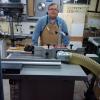I learned many of my woodworking practices from a mentor who advised to take light passes when using machines with rotating blades i.e. jointer, planer, router.
His logic was that numerous lighter passes will not only be easier on machine, but more importantly easier on the cutting edges. Not to mention reducing the risk of tear out and grabbing grain.
So my practice has always been to take very light cuts even if it means more time and more passes. Often times sound is a good feedback. The sound of a lighter cut is normal to me, but when the machine is taking a heavier cut I'm conditioned to wince.
The thing is I can't scientifically prove whether this belief is a fallacy or not. After all, could the physics of taking 1/32 depth cuts instead of 1/16 or 1/8 really make a meaningful difference in cutter life?
Does it make a difference if the cutter is carbide vs HSS?
What do you think?




 Reply With Quote
Reply With Quote





